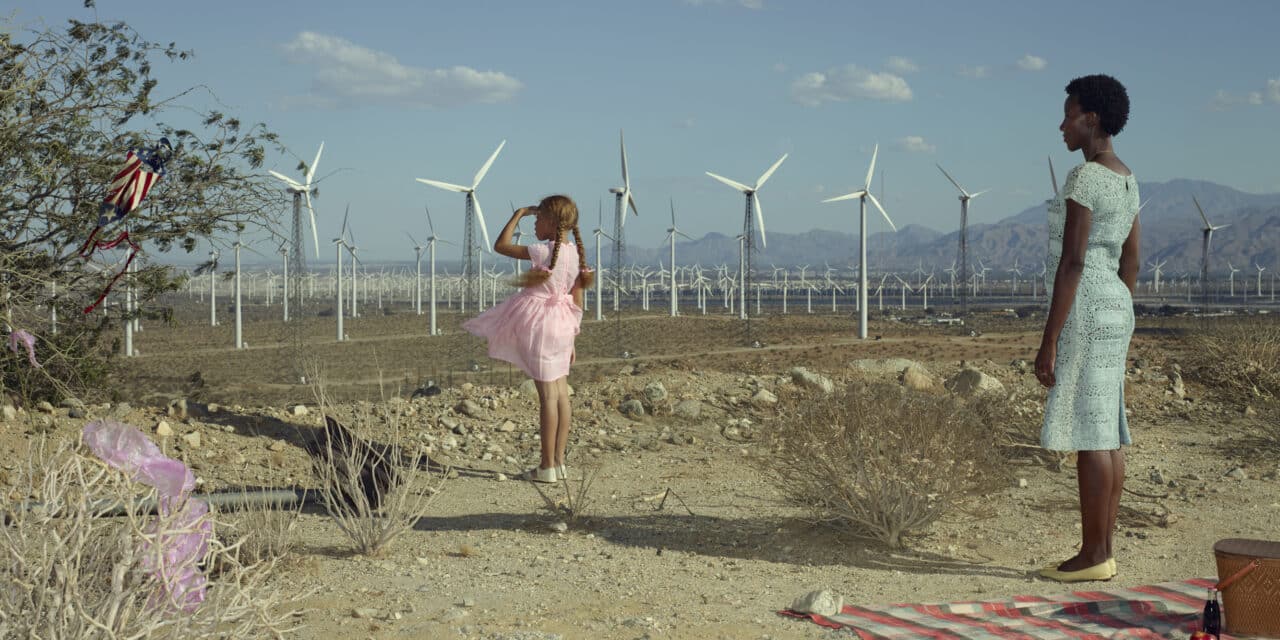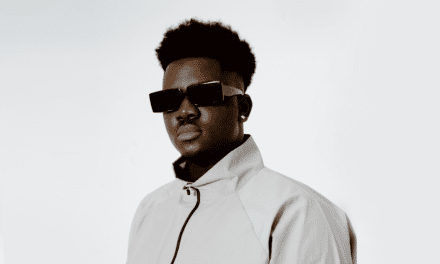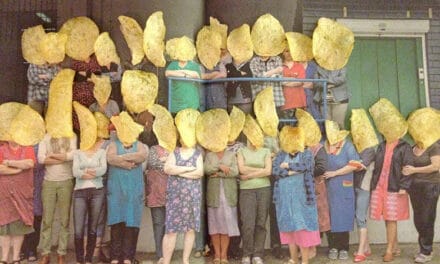Erwin Olaf, The Kite, Palm Springs series, 2018, © ERWIN OLAF, STUDIO ERWIN OLAF / GALERIE RON MANDOS – AMSTERDAM, THE NETHERLANDS
One thing must be said about the canonical media of artistic expression: their classification is as simple and as unequivocal as it comes. Regardless of all the possible whimsicality in its execution or the varying purposefulness of its content, a painting is always a painting, a sculpture is a sculpture, a song is a song. As such, they can be straightforwardly considered works of art, and the judgment probably won’t be questioned by anyone. Now, about photography, the possibility of putting its artistic status up for discussion arises almost as often as it doesn’t for the previously mentioned media. The blurred lines between creation and representation typical for this channel of visual expression, as well as the pivotal role it plays in the history of both art and journalism, make it especially difficult to determine where a photo as a form of documentation ends and a photo as a work of art begins.
The matter becomes even more complicated when any degree of political engagement is involved: to want to send a message or reflect on an issue through a photograph usually means to stage it, at least to some extent. One needs to choose what to depict and how to depict it, rather than capturing the passing moment as it fades. It’s a process of crafting like any other, with the only difference being that actual, flesh-and-blood people serve as material. At the same time, it’s those flesh-and-blood people whose reality the photo wants to comment on. It needs to stay close to this reality, constituting, in a sense, its extension. Thus, the photographer’s job is not an easy one: how to reconcile those two objectives? How do you discuss the real world while being a part of it? Or grasp in the still perfection of a picture all the imperfections of motion life? Erwin Olaf asked himself all of them. And it’s safe to say he succeeded in finding the answers.

Erwin Olaf, Separation 1, Separation series, 2003 © ERWIN OLAF, STUDIO ERWIN OLAF / GALERIE RON MANDOS – AMSTERDAM, THE NETHERLANDS
Erwin Olaf (1959–2023), a Dutch photographer whose professional trajectory is a perfect exemplification of curious liaisons between creativity and commentary on current events this medium allows for, is the main protagonist of the latest exhibition Narratives of Emancipation, Desire, and Intimacy (Narrativas de emancipación, deseo e intimidad in Spanish), held in Madrid from May 10th until July 14th, 2024. Organized by PHotoESPAÑA, an annual festival of photography based in the capital of Spain and acquiring more and more international recognition every year, the show is a tribute to the late creator and the first individual display of his work after his death in 2023. It focuses on the key component of Olaf’s work, a recurring phenomenon that he explored in all its dimensions: the human body. ‘Renouncing the traditionally chronological approach of retrospectives, the exhibition has been conceived around three aspects that articulate Olaf’s multifaceted and engaged artistic practice: emancipation (the political body), desire (the sensual body), and intimacy (the affective body)’, says Paco Barragán, the curator of the show.

Erwin Olaf, Masonic Lodge, Dahlem, Berlin series, 2012 © ERWIN OLAF, COURTESY STUDIO ERWIN OLAF / GALERIE RON MANDOS – AMSTERDAM, THE NETHERLANDS
Indeed, the body always occupies the central part of Olaf’s compositions, whether it’s to explore its interdependencies with its entourage or to expose its own limitations and possibilities. The human body in Olaf’s work seems to have superpowers: it’s the driving force not only of the artistic arrangement of each photograph, but also of the message behind it. The artist is truly committed to depicting the unobvious: more often than not, his models represent diverse ethnicities, body types, and beauty standards, the juxtaposition of which creates a magnetic visual tension. ‘I made a decision to show a wide variety of beauty’, he says in an introductory video to one of his photo series, Palm Springs. ‘I wanted
to show the new world. As you can see nowadays in the streets, because of love and sexuality, we see this beautiful mixture of skin tones. So, I selected on character, body form, but mostly on gradation of skin tone, to show the beauty of it.’
On the aesthetic level, pursuing beauty really determines the decisions underpinning Olaf’s creative practice. His pictures come across, and deliberately so, as strikingly theatrical: they are staged to the point of utmost perfection, where no gaze falls an angle too low, no finger is placed an inch too far, no background prop is mislaid. This impeccable, carefully crafted nature of Olaf’s work contributes to creating a tension so strong it’s almost palpable. Simple in form but immaculately executed, the structure of his photographs positions them just on the line between still and motion picture, playfully adding another layer of interpretation: the human aspect of it all. It’s in those strains between the characters, in the collocation of their bodies and the expressions on their faces, that the stories take place. We don’t necessarily comprehend the message the picture is trying to put forward; we feel it.

Erwin Olaf, American Dream, Self-Portrait with Alex 1, Palm Springs series, 2018 © ERWIN OLAF, STUDIO ERWIN OLAF / GALERIE RON MANDOS – AMSTERDAM, THE NETHERLANDS
In the overall amazement, understandably caused by such hypnotic perfection, it is easy to overlook the actual reason Olaf’s work resonates so much with the spectator. When looking at his pictures, one is naturally mesmerized, but there’s more: they are, for the most part, deeply unsettling, almost upsetting. And one cannot fully understand why. It is, however, a continuation of the photographer’s creative approach, which assumes fitting all the elements into a puzzle so coherent that even the discrepancies seem in line with it. He openly seeks to bewilder the viewer, leaving him with just a whit of perturbation the latter doesn’t even notice at first: ‘The production team suggested spraying that grass green. It’s nice that people want to do something like that for you, but that wasn’t at all what I wanted. The withered grass gives this fabricated, artificial world of Palm Springs something beautifully poignant’.
Funnily enough, the flawlessness of his work is a direct reflection of how flawed, perplexing, and chaotic our own reality can be. It is not a praise of a glorified wonderland; it is a representation of the man-made paradise that is now beginning to crack. The close connection Olaf’s pictures establish with the modern-day world is, after their theatricality, their most distinguishable trait. Throughout his entire career, which started with photojournalism, political engagement traverses his artistic creation, each photo or photo series constituting a statement of its own. In this perspective, the recurrent element of the human body is used as a channel to convey the message, whether it’s the climate disaster causing yellowing grass and water shortages (Palm Springs), society’s obsession with youth and beauty (Mature), its simultaneous sexual fixation and nude-related prudishness (Skin Deep, Rome), or the perverse complexity of child-adult relationships (Berlin, Separation). His visual metaphors, simple but brave and carried out to perfection, let the interpretation smoothly slide into the viewer’s subconscious, where it nests even more permanently as it uses bodies like our own as the main motive power.

Erwin Olaf, 9:50 am, April Fool 2020 series, 2020 © ERWIN OLAF, STUDIO ERWIN OLAF / GALERIE RON MANDOS – AMSTERDAM, THE NETHERLANDS
Thus, the human body, being the central theme of PHotoESPAÑA’s exhibition, is also the fulcrum of Erwin Olaf’s creative and social activity. The bizarre boldness of his compositions makes them so irresistibly captivating that one surrenders without a fight. We want to immerse ourselves in his world, which, even if distorted and twisted, says something about the one we live in. In one of the videos accompanying the show, the artist mentions a certain feeling his mother described as ‘always looking for home, even when you’re at home.… That is, let’s say, the emptiness that I feel myself sometimes. So, what I try to photograph is this non-emotion, not unhappiness, but the edge of every emotion. You can cry or laugh at any second’. And that is exactly what the reception of his work feels like. It makes us feel something so powerful and unique that we want to keep experiencing it, regardless of the mental state we are left in afterwards. Olaf’s vision of reality – crafted, but both seductive and overwhelming – eventually crashes with the surroundings of actuality – rather insipid in comparison – and it is at the junction of these two extremes that the emotional experience of art begins. In the end, what his work gives us is what we most thrive on: the flesh and blood of human existence.
https://phe.es/exposicion/erwin-olaf-narrativas-de-emancipacion-deseo-e-intimidad/





PHotoESPAÑA24: Erwin Olaf. Narrativas de emancipación, deseo e intimidad





